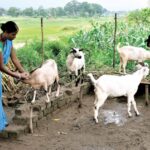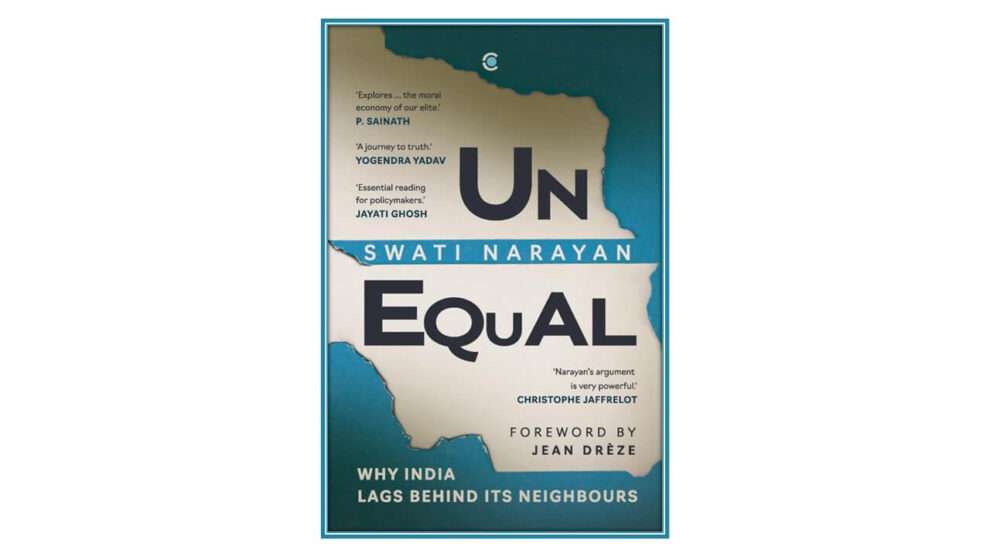Swati Narayan (2023)
Publisher: Westland Books, India
Pages: 368 pages
ISBN: 978-9357769983
Price: INR 799
Until 1980, women in India lived longer than many of their counterparts in South Asian countries. But by 2021, women in countries like Bangladesh were expected to live longer than Indian women. This was attributed to their accessibility to better healthcare services in Bangladesh. Similarly, many countries which were weaker than India, some fifty years ago, are faring better than India on many social indicators such as education, healthcare, nutrition, gender equality, etc. As per the World Inequality Report (2022) inequality was so marked in India that the bottom half of its population had to survive on only 6% of the nation’s wealth. At least 41% of India’s wealth was in the hands of the forward castes, double their population share. Inequalities in wealth are being perpetuated over the years by the prevailing caste system, extreme gender inequalities, and low literacy.
This book by Swati Narayan focuses on finding answers to the question: ‘Why is India, though economically strong, lagging behind its neighbouring poor countries in social development?’ She points to the variations in social welfare indices: i) education, ii) health, iii) social equity, and iv) women’s empowerment between India (represented by Bihar) and its eastern neighbours, Bangladesh and Nepal. The data revealed that Bihar is lagging behind both Bangladesh and Nepal on all four indices. The question then arose as to why it was so. The author came up with very interesting findings based on her personal interviews with 1600 rural women spread across 80 villages in four districts of three countries – India, Nepal and Bangladesh. Then she crosschecked the data by interviewing policy makers, teachers and health workers. This data from her extensive field work was analysed and interpretations made by corroborating through a robust review.
For instance, in Bihar 82% of students enrolled in private schools and 44% in government schools went for private tuitions indicating thereby the dominance of private coaching centres. Percentage of teacher absenteeism on the day of the author’s visit was as high as 41% in Bihar, but only 32% in Nepal and 18% in Bangladesh. The schools in Nepal and Bangladesh had better infrastructure facilities in terms of wooden chairs and desks for the children, and supply of text books in time whereas the children in Bihar schools sit on dusty floors and the supply of text books is delayed for months. More than two-thirds of schools in Bangladesh and Nepal had toilets. In Bihar, more than half of the schools had no toilets, and this could be one of the reasons for girl students to drop out.
The healthcare centres in both Bangladesh and Nepal are highly accessible to women and had a good supply of free basic medicines. On the contrary the healthcare centres in Bihar were distantly located and as such not easily accessible to women. The percentage of homes which had usable toilets and were in use was about 99% in Bangladesh, 96% in Nepal and a poor 14% in Bihar. The mothers of school children (who were mostly literate) had frequent interaction with the school teachers in Bangladesh and Nepal. Similarly, in these two countries the doorstep healthcare workers frequently visit the houses and were more respected by the people. Because of caste discrimination and low literacy of women in Bihar, their interaction with teachers and healthcare staff was very poor. Discrimination faced by women in Bihar was more pronounced as they were the last to take food at home. In Bangladesh and Nepal all the family members, including women, dine together.
The author also explored how Bangladesh and Nepal were able to reduce the inequalities of wealth, caste, and gender. She discusses the importance given by Bangladeshi political parties to social welfare and the role of two big NGOs, namely BRAC and Grameen Foundation, in reducing inequalities in Bangladesh. In Nepal, the following four factors accounted for mitigating social inequalities and these include: Jan Andolans (people’s movements), the Dalit movement, international migration, and the Maoist people’s war.
In view of the fast progress made by Kerala, Tamil Nadu and neighbouring Sri Lanka, Swati Narayan considered them to be super models that could be emulated in other states of India. She describes the developments in Sri Lanka from 1830 to 1977, Kerala 1820 to 1975, and Tamil Nadu 1961 to 2023 based on the available secondary data. Economically, though not strong, the two Indian states and Sri Lanka have done well in the matter of human development. Though Sri Lanka, Kerala and Tamil Nadu differ in their history, languages and culture, there are certain similarities which include social reform movements, universal public services, women’s agency, and cultural ties.
The author highlighted three important turning points which led to the empowerment of women in Kerala and Tamil Nadu. These were Kerala’s Channar Upper Cloth Revolt for dignified clothing and Tamil Nadu’s Dravidian Self Respect Movement to achieve social equality for the oppressed castes. The Government of Kerala encouraged the Self-Help Groups (Kudumbashree) to converge with the Mahatma Gandhi National Rural Employment Guarantee Scheme (NREGA) and now most of its workers are women (90%). Similarly, anganwadi workers (mostly women), are not only providing food to the children twice a day but also engaging them in games and learning.
The encouragement from the successive governments in Tamil Nadu helped more women to work in the schools, anganwadis, health centres, textile mills, etc. So, women’s employment increased to 38% in 2019-20 which was higher than the national average of 22%. The migration of women over the years to the Gulf countries also increased and they started working as car park attendants, police, and bus conductors which were all earlier considered as male dominated jobs.
As suggested by the author, India has to learn from the experiences of these small and economically poor neighbouring countries, as well as Kerala and Tamil Nadu, and aim at providing access to better education, good quality healthcare services, improved nutrition and hygiene, especially to those who are on the lower rungs of human development.
India being a vast country with a huge population and varied culture, it is not that easy to achieve the desired outputs. Nevertheless, it is not a distant dream for India to achieve all-round development if there is political will, along with enhanced budgets for welfare, through effective implementation of the schemes under various sectors, and by roping in NGOs and philanthropists.
This book contains valuable information for policy makers, academicians and extension professionals who are involved in planning and implementation of rural development projects in South Asia and elsewhere. Faculty and students in agricultural extension might find this publication very relevant as it will heighten their curiosity in developmental issues and broaden their perspectives on rural development.
Dr SVN Rao
 Dr SVN Rao retired as Professor and Head, Department of Veterinary and Animal Husbandry Extension Education, Rajiv Gandhi Institute of Veterinary Education and Research (RIVER), Puducherry. He can be contacted at: svnrao1953@gmail.com
Dr SVN Rao retired as Professor and Head, Department of Veterinary and Animal Husbandry Extension Education, Rajiv Gandhi Institute of Veterinary Education and Research (RIVER), Puducherry. He can be contacted at: svnrao1953@gmail.com









“This is a Bihar vs Bangladesh and Nepal study. Bihar does not represent all of India, especially on the key social welfare indices studied, education, health, social equity, and women’s empowerment. Drawing conclusions on India using Bihar data is a wrong use of social science research methodology. Interestingly, the author quotes two south Indian states Tamil Nadu and Kerala as “supermodels” and this looks like a contradiction.